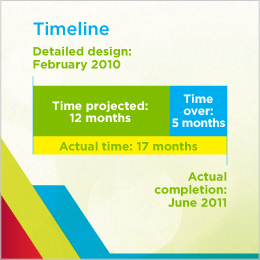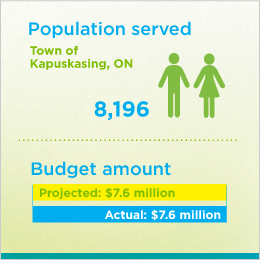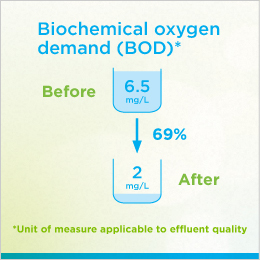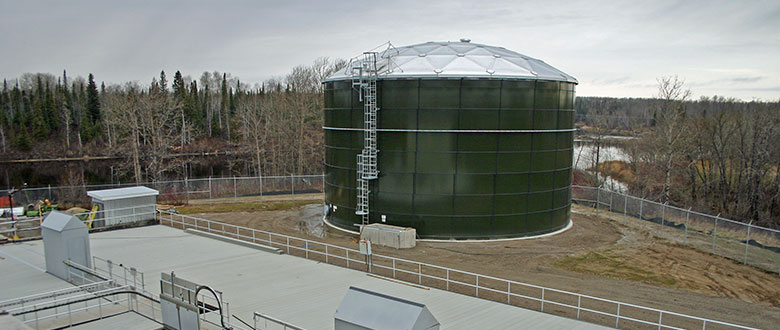This is part of a series of case studies on wastewater projects funded by the FCM's Green Municipal Fund. Each case study provides technical information, project details and tips on best practices.
Project overview
The Town of Kapuskasing, ON, updated its wastewater treatment plant (WWTP) with several new technologies, including an aerated lagoon with coarse bubble aeration and a SCADA (supervisory control and data acquisition) system for process automation. UV disinfection replaced the use of chlorine gas, improving health and safety for the public and plant workers.
The upgrades increased the capacity and extended the service life of the WWTP, which offers tertiary-level water treatment to a population of 8,196. The $7.6 million project improved the quality of effluent, bringing the town into compliance with provincial standards. The new system also improved biosolids management, reducing the amount of waste transported to the town landfill.



Reasons for the project
- The equipment was reaching the end of its lifetime.
- The plant was non-compliant with Ontario Ministry of Environment standards for E. coli.
- Untreated discharge was going into the Kapuskasing River.
Innovative aspects of the project
- Local procurement requirements helped to ensure that money stays in the community.
- Kapuskasing set a good example by coupling value engineering with an energy audit to guide system improvements.
Best practices and key lessons
The municipality's experience with this project demonstrates some best practices and key lessons that can inform similar projects.
Use alternatives to lowest-bid procurement
- The town only accepted bids from pre-qualified bidders who surpassed a certain point score.
- Interested bidders submitted detailed proposals that included the following elements: scope of work, drawings, project specifications, a completed pre-qualification form, and details on equipment such as price, warranty, delivery and installation.
- In anticipation of an eight-month delay in equipment delivery, the town pre-selected the equipment to be used for the project.
Consider hiring a managing contractor
- Kapuskasing hired one contractor who was responsible for managing all subcontractors, including the equipment supplier.
Ensure that there is sufficient baseline environmental data to support post-project reporting and analysis

The Town of Kapuskasing’s new biosolids storage tank. (Credit: Town of Kapuskasing)
Project benefits
This project yielded a number of environmental, social and economic benefits.
Environmental benefits
- Lower energy usage: The upgraded WWTP now includes equipment controls, variable frequency drives and high-efficiency motors on all new building mechanical and process equipment, reducing electricity usage.
- Improved wastewater quality: The reduced frequency and volume of raw sewage bypasses, the increased biosolids storage capacity and the replacement of chlorination with UV disinfection all have a direct benefit on the quality of water released into the Kapuskasing River, including reductions in total suspended solids (TSS) and biochemical oxygen demand (BOD) in effluent.
- Solid waste reduction: The improved biosolids treatment and storage facilities have reduced the volume of biosolids hauled off-site.
- Lower environmental impact: The new system has improved the quality of treated effluent.
Social benefits
- Decreased risk to public health and safety: Because chlorine is no longer used for disinfection, there is no more chlorine in the effluent water discharged to the river and no risk of a chlorine gas leak.
- Increased worker safety: Replacing chlorination with UV disinfection has improved worker safety.
- Increased opportunities for recreational activity and improved access to public space: Reduced frequency and volume of raw sewage discharges to the Kapuskasing River improves the river's water quality, increasing healthy, safe access for recreational fishing.
Economic benefits
- Reduced operating costs: Improved treated effluent quality, biosolids treatment and storage facilities have reduced the volume of biosolids being hauled off-site. This has resulted in a reduction of all associated costs.
- Municipal cost savings: Treated effluent is used to cover material at the landfill, reducing the need to buy cover material.
- Creation of a new revenue stream: The town will generate revenue by offering sludge handling services to neighbouring municipalities.
- Increased tourism revenue and benefits to local business: Reducing the frequency and volume of raw sewage discharges to the Kapuskasing River has improved the river's water quality, making the area more inviting for tourists and increasing the health of local fisheries.
- Increased service life: The upgrades will extend the service lives of the WWTP and the town landfill.

Technical highlights
Technical highlights are current as of 2014.
Treatment
- Sewage pumping using two screw pumps
- One mechanical screen
- One detritus tank
- Two aeration tanks
- Two rectangular secondary clarifiers
After
- New raw sewage grinder
- Addition of coarse bubble diffusers to aeration tanks and dissolved oxygen probes
- Replacement covers for clarifiers
- Implementation of programmable logic controller and SCADA systems
Disinfection
- Before: Chlorine disinfection system - 401 CFU/100mL
- After: UV disinfection system - 23 CFU/100mL
Biosolids management
- Before: On-site storage and periodic disposal of liquid biosolids for agricultural application
- After: Expanded storage capacity with ability to thicken biosolids to 25 per cent to 29 per cent. Biosolids periodically trucked to landfill for use as cover.
Annual average daily flow (AADF)
- Current: 5.5 MLD (million litres per day)
- Design capacity: 9.1 MLD
Per cent of total capacity used for AADF: 60 per cent
Total suspended solids (TSS)
- Before: 4.8 mg/L
- After: 7.1 mg/L
Project contact information
Yves Labelle
Chief Administrative Officer
Town of Kapuskasing, ON
T. 705-337-4252
Want to explore all GMF-funded projects? Check out the Projects Database for a complete overview of funded projects and get inspired by municipalities of all sizes, across Canada.

